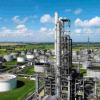|
|
Hp Flare Ko Drum Design
#1

Posted 07 September 2011 - 01:39 PM
I've recently started working for an oil and gas consultancy company and I'm currently looking over some sizing calculations that were performed for a new HP flare KO drum on an offshore platform.
The HP flare drum was sized based on a blocked outlet on the inlet HP separator with the two highest producing wells continuing to produce into the separator. When determining the gas / liquids flow rates into the HP flare KO drum a HYSYS simulation was developed. In this the relieving pressure was set as the PRV set point + 10%. This stream was then dropped over a valve to 0.5 barg (assumed KO drum operating pressure) and the stream properties then used as the basis for sizing the KO drum.
Being new to this field I was hoping someone could clarify a few queries I have:
1) Is it standard practice to assume the sizing case for a HP flare KO drum in this service is a blocked outlet with the highest two wells still producing? (I presume this would only be the case if there is no compression??)
2) When determining the stream properties on the outlet of the PRV, is it correct to set the pressure of the stream in HYSYS as the PRV SP + 10%? e.g. if the PRV set point is 10 barg, the value used in HYSYS is 11barg?
Related to this (apologies in advance for all the questions!), one additional query I had was in relation to the SP for high pressure trips. Are these set at the same pressure as the PRV, e.g. if a HP separator had a PRV with a SP of 11barg, would the high pressure trip on the ESD system also be set at this pressure? Or is it set slightly lower?
Yours hopefully!
David
#2

Posted 08 September 2011 - 12:25 AM
My answer to your last question:
High pressure trip on the ESD system should be set at slightly lower than the relevant PSV set point.
Fallah
#3

Posted 08 September 2011 - 04:19 AM
I concurred with fallah on the tripping system.
For question 1, I cannot give a specific answer since I have no experience with off-shore installation. However, in general we normally consider the worst case emergency scenario such as blocked discharge, fire, utility failure etc.
If in your case blocked discharge is the worst case, then you are in the right track.
For question no 2, I am no very sure the reason for your question. However, if the reason is for you to use HYSYS in order to determine the vapor/liquid ratio in the KO drum, then you can use the pressure as mentioned by you and flash it at 0.5 barg (the assumed drum pressure).
Refer to API RP 521 for more details.of KO flare drum sizing.
Edited by S.AHMAD, 08 September 2011 - 04:30 AM.
#4

Posted 08 September 2011 - 04:25 AM
Is it standard practice to assume the sizing case for a HP flare KO drum in this service is a blocked outlet with the highest two wells still producing?
It is common practice to consider this scenario as the relief case from the first stage separator, provided that sufficient shutdowns are in place to act on the well wing valves or master valves on high level or high pressure. This becomes the sizing case for the flare drum only if there is no larger relief flow (eg from a compressor) or blowdown flow (eg from total system blowdown).
No - or perhaps I have misunderstood you? The properties you quote are at the INLET of the PSV. In HYSYS you create a stream with these properties going INTO a valve, then set the pressure at the OUTLET of the valve equal to the flare system back pressure.
one additional query I had was in relation to the SP for high pressure trips. Are these set at the same pressure as the PRV, e.g. if a HP separator had a PRV with a SP of 11barg, would the high pressure trip on the ESD system also be set at this pressure? Or is it set slightly lower?
As Fallah says, set the trip to be slightly lower. Its purpose is to cause a shutdown while avoiding the opening of the PSV. The PSV is the backup in case the trip doesn't operate. If the trip fails, then maybe none of the wells will close - which is why, as in my answer above, you need more than just one high pressure trip if you are to limit the relief case to two wells.A high level trip, also acting on the well valves, will provide the additional integrity.
Paul
#5

Posted 08 September 2011 - 07:10 AM
Paul, in regards to the HYSYS stream. Perhaps I didn't describe the simulation clearly as I think what you are descirbing is what has been done- a stream was developed based on the inlet conditions to the valve, e.g. 11 barg (SP + 10%), this was fed to a valve and the pressure on the outlet stream from the valve set at 0.5 barg to represent the operating pressure in the KO drum. These stream proporties were then used as the basis for sizing the KO drum, e.g. liquid, gas flowrates etc...
David
#6

Posted 12 October 2011 - 02:25 PM
Actualmente cuento con un diseño en el cual todas las corrientes de alivio se dirigen a un solo tanque el cual se conecta al flare.
Me han recomendado separar en dos sistemas uno de alta presión con un depósito y un flare dedicado, y otro sistema de baja presión con un depósito propio y otro flare dedicado.
Como comprenderán este cambio significa una inversión, por lo que solicito me ayuden a diseñar un sistema adecuado
Similar Topics
Flare Header Reverse FlowStarted by Guest_Ahmadhamzahperta_* , 04 Apr 2025 |
|

|
||
Compressor Suction DrumStarted by Guest_Lyne_* , 04 Jul 2025 |
|

|
||
Design Capacity Of Hydrogen Pullet During Hydroprocessing Units UpsetStarted by Guest_Divid Kelin_* , 18 Jun 2025 |
|

|
||
Hot Oil Loop / Heating Medium DesignStarted by Guest_Lyne_* , 30 Mar 2024 |
|

|
||
Hello, Design Of Natural Gas Liquefaction Processes.Started by Guest_guoyinyanliner_* , 18 Jun 2025 |
|

|

 FB
FB








